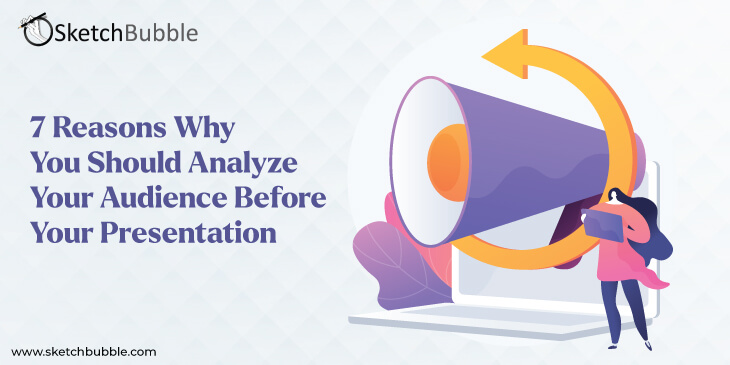If you’re looking to land a deal or disseminate information, you need to make a compelling presentation. But before you proceed with polishing your tone and slide design, there’s something else you need to consider: your audience.
Who are they? How much do they know about your topic?
More than just answering these questions, here are eight reasons why you should analyse your audience before your presentation.
Key Highlights: 7 Reasons to Analyze Your Audience Before Presenting
- Tailor Your Presentation: Understanding audience demographics helps in crafting a presentation that resonates, ensuring relevance and engagement.
- Speech Adjustment: Modifying your language or technicality based on the audience’s knowledge ensures your message is comprehensible and retains interest.
- Topic Selection: Audience research guides you in choosing topics that captivate and hold the attention of your listeners, boosting engagement.
- Connection Building: Knowing your audience enables you to establish a relatable context, making your presentation more impactful and memorable.
- Pain Point Identification: Delving into your audience’s challenges allows you to align your presentation with their needs, fostering a stronger connection.
- Preparation for a Diverse Audience: Creating a theoretical audience profile aids in refining your presentation to appeal to a wide range of listeners.
- Respect and Sensitivity: A thorough understanding of your audience’s beliefs and values leads to a respectful and ethically sound presentation, avoiding offense and enhancing receptivity.
1. Your Audience Can Help You Deliver the Right Presentation
Presenting data is not a one-size-fits-all endeavour.
If you want to create a presentation that’ll draw people, then you need to research the audience:
- Age range
- Gender
- Educational level
- Religion
- Culture
- Values, Beliefs, or Attitudes
By getting such details, you’ll know what to focus on – and what you can safely trim from the slides. You wouldn’t want to give a college-level, technical presentation to 16-year-olds, wouldn’t you?
Likewise, you wouldn’t want to start with a joke that’s deemed offensive by your audience.
Now, it’s easy to get such information when you’re presenting to a homogenous team at work. You can use the existing data, such as their HR profiles.
But how can you do this for a public speaking event?
To gain your audience’s insight, you can directly observe the audience.
You can also interview a small group or ask them to answer your questionnaires. Doing this will give you a ‘feel’ of the audience, which can serve as a jump point for your preparation.
2. It Can Help You Adjust Your Speech Accordingly
Say you need to discuss a topic in front of various audiences. Even if you already have a script, it doesn’t necessarily mean that you should follow it to the tee. You will need to revise some points so that they’re better digested by your listeners.
For example, if your presentation uses highly technical terms, you can use simpler words that laypeople will easily understand.
3. It Can Help You Choose a Suitable Topic
Maybe you’ve been given the honour to speak in front of Sociology majors. You have the freedom to choose from any other subject. The only question is, what topic will you present to them?
If you did not research the audience, you could easily fall into the trap of discussing something that they find uninteresting. And because they don’t see any value in it, you won’t get these people to listen to you willingly.
Remember: the right topic will keep them glued to your presentation.
4. It Can Help You Establish a Link With Your Audience
Researching your audience will allow you to ‘walk in their shoes.’
As a presenter, you will want to establish a connection with your audience. You’d want to deal with something they can relate to, especially when it comes to detailed presentations.
For example, you’re about to present to a team of doctors and nurses about financials. You can connect to them by using medical or health-related scenarios when discussing the more technical aspects of the presentation.
5. It Helps You Identify With Your Viewers
If you’re presenting something that aims to solve a problem, you need to rally the audience behind you. The only way you’ll be able to do this is if you can relate to their pain points.
Researching your audience can help you explore the issues that they feel. Like them, were you unable to fulfill your tasks – because of a policy or the lack of equipment?
When you identify with them, you can expect better support. After all, you can relate to it.
6. It Can Help You Prepare in Front of a ‘Theoretical Audience’
Learning more about your attendees can help you prepare for a theoretical audience.
As the name suggests, it’s all about creating a presentation that will compel your make-believe viewers. With this, you’ll be able to determine the ‘right’ speech that your diverse audience will understand.
With your theoretical audience, you can perfect your presentation by fine-tuning the terms, points, and opinions you wish to discuss.
7. It Will Help You Create a More ‘Respectful’ Presentation
If you’re dealing with a diverse audience, not researching their beliefs and attitudes could prove catastrophic to your presentation.
You don’t want this to happen, of course. When you offend your audience, there’s no chance that they’ll listen to you. Worse, they might even walk out of the room.
This is why you need to be guided by your ‘theoretical audience.’ With this, you can create a respectful presentation that adheres to the following ethical guidelines:
- Only present accurate facts.
- Avoid manipulating your audience’s feelings.
- Don’t use hateful, belittling words.
- Be sensitive – only use the ‘right’ ways to identify the audience (i.e., disabled instead of crippled.)
There you have it – the eight reasons why you should analyse your audience. If you ever find yourself wanting to skip this step, think about this: proper preparation prevents poor performance!
